Western North America is a patchwork is hundreds of terranes, which are crustal pieces or microplates (think of islands), that collided with and attached to North America across hundreds of millions of years -- adding piece-by-piece to the continent's width and building mountains as they produced volcanoes or pushed up sediments and rocks. This posts provides a very simplified timeline of the major orogenies and terranes that affected western North America. For a more in-depth look, see the resources below.
Slideshow
Precambrian
- Passive margin
- Cratonic, continental shelf deposits
Paleozoic
- Antler Orogeny: Late Devonian - Early Mississippian (375 - 300 Ma)
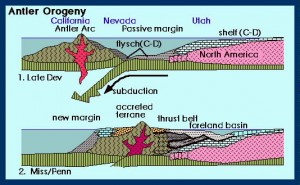
- Poorly understood: involves subduction, accretion of one or more island arcs to the passive margin, and widespread folding and thrust faulting (Roberts Mountain Allochton thrust over passive margin)
- Rocks in Utah; foreland basins form in Neveda
- Sonoma Orogeny - Permian - Triassic
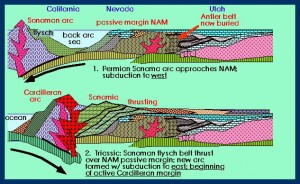 (280 - 200 Ma)
(280 - 200 Ma)- Poorly understood, existence debated: theories include accreting island arcs (McCloud arc); convergent processes throwing oceanic sediments (Havallah terrane) onto crust via Golconda thrust; back-arc thrusting
- Terranes include: Brooke Range (AK), Stikine (BC), Sonoma (NV)
Mesozoic
- Nevadan Orogeny: Jurassic (180 - 140 Ma)
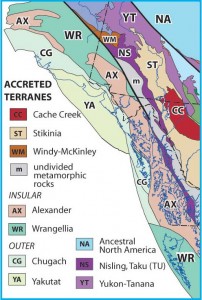
- Oceanic lithosphere subducts along edge of North America
- Subducting plate dehydrates, releases volatiles, causing partial mentling in mantle above plate
- Magma rises to produce Andean-style stratovolcanic arc underlain by large batholiths (Sierra Nevada batholiths)
- Wrangellia: Cretaceous (145 - 66 Ma)
- Large flood basalt terrane, reaching from British Columbia to Alaska, docks to North America
- Sevier Orogeny: Jurassic - Eocene (120 - 50 Ma)
- Subducting oceanic Farallon plate and accreting large terranes cause stacking up and eastward pushing of upper crustal thrust-fault slabs, mainly sedimentary rock
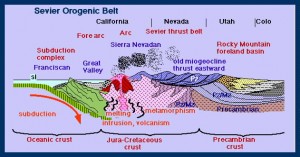 Cenozoic
Cenozoic
- Laramide Orogeny: Late Cretaceous - Paleogene (80 - 40 Ma)
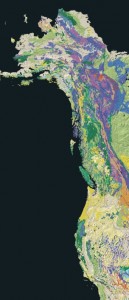
Youngest to oldest rocks: yellow, green, blue, purple. Image credit: USGS, North American Tapestry of Time and Terrain
- Rapid shallow angle subduction drags Farallon plate along base of North America (flat-slab subduction)
- Many hundreds of miles inland, plate angles down into the deeper mantle
- Friction of dragging plate causes stress, uplifting the Laramide mountain ranges (e.g. the Rocky Mountains)
- Basin and Range: Miocene (17 Ma) - Present
- Extensional event related to transform plate boundary (San Andreas fault)
- Tension across the region pulls crust apart; crust stretches, rifts, and form grabens (rift valleys) with uplifted horsts ("mountains")
- Delamination (lower crust "shaved off") and isostatic uplift from high heat flow from mantle
- Cascadia Orogen: Oligocene (34 Ma) - Present
- Juan de Fuca plate, remnant of Farallon plate, continues to subduct into Cascadia subduction zone
- Coastal ranges, consisting of accreted oceanic and ocean island crust, continue to accrete and uplift along coast
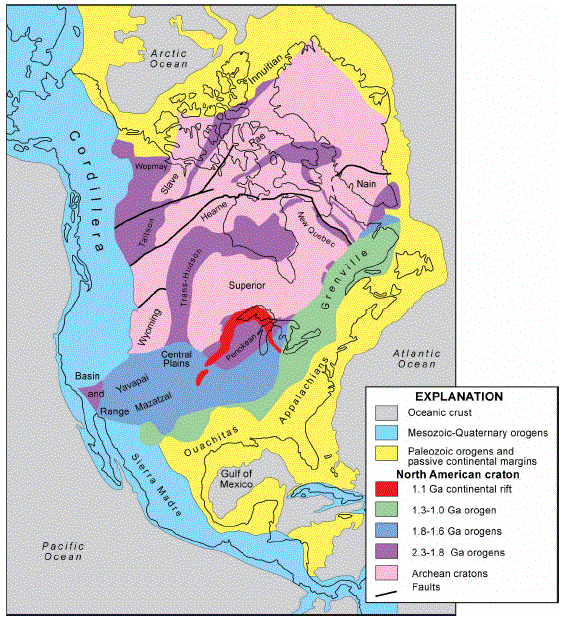
Map of North American showing the geology of the North American craton underlying the sedimentary rocks that cover much of the continent. Modified from Hoffman (1989). Image credit: http://home.hiroshima-u.ac.jp/er/Rmin_EG_KS_01_US.html
Online Resources
- Tectonic History of North America by Period: https://www2.nau.edu/rcb7/hist_by_period.html; see also: https://www2.nau.edu/rcb7/Text_WUS.html
- Geology of the Pacific Northwest: http://commons.wvc.edu/rdawes/FocusPages/FPindex.html
- North American Orogenies: https://en.wikipedia.org/wiki/List_of_orogenies#North_American_orogenies
- Mesozoic Tectonics of North America: http://www.usouthal.edu/geology/haywick/GY112/ppt/112-pp30.pdf
- Wrangellia Terrane: http://www.eos.ubc.ca/research/wrangellia/background.html
- MIT Field Geology of Western US: http://ocw.mit.edu/courses/earth-atmospheric-and-planetary-sciences/12-114-field-geology-i-fall-2005/lecture-notes/
- Terranes Explained: http://www.virtualmuseum.ca/sgc-cms/expositions-exhibitions/logan/en/index.php?/md/research/platetectonics/TerraneExplained
- Western North American Orogenies: http://www.nsm.buffalo.edu/courses/gly481-581/WC_Intro.pdf
- History of the Western US: http://pages.uoregon.edu/ghump/Lectures_files/_wUS_history.pdf
- Orogeny Illustrations: https://www2.nau.edu/rcb7/geology_illustrated.html
- Paleogeographic and Tectonic History of Western North America: http://cpgeosystems.com/wnampalgeog.html

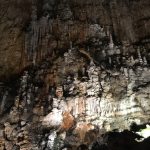
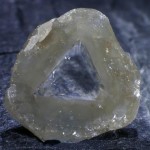
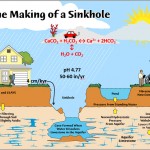
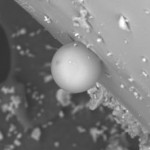
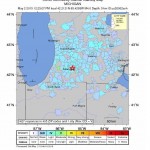
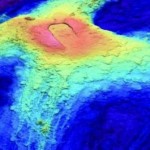
Looks pretty good